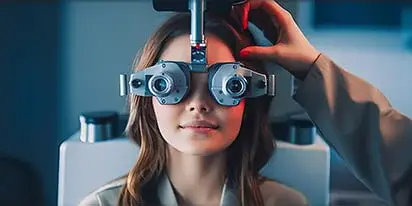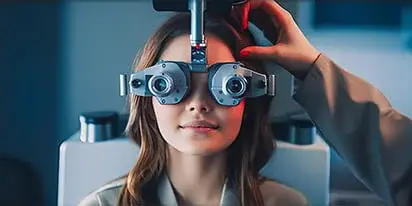Refractive errors are a type of vision problem that makes it hard for your eyes to focus correctly on objects you’re looking at causing distorted vision. They are the most common type of vision problem. Several parts of our eyes work together to pass the light that enters them onto the retina and further along a pathway to your brain. Refractive errors happen when the improper shape of your eyes keep light from focusing correctly on your retina.. Regardless of the type of refractive error you have, an eye care specialist can diagnose and treat it. Most people with refractive errors develop them over time as they grow up. Mostly, refractive errors first appear during childhood. But you can develop a refractive error at any point in your life, even if you’ve had clear vision before.
What are the types of refractive errors?
The four most common types of refractive errors include:
- Nearsightedness/ Myopia
If you face difficulty in seeing distant objects, but can see objects that are close to you clearly, then you have myopia. For example, people with nearsightedness won’t be able to make out signs on the side of the road until they’re just a few feet away or right outside of their car. Nearsightedness could happen if your eye grows too long from front to back or if your cornea or lens is too curved. Nearsightedness usually develops in kids when they’re around 8 years old or if parents have myopia.
- Farsightedness/ Hyperopia
If you face difficulty in seeing objects close to you clearly, then you have hyperopia; a condition that’s the exact opposite of myopia. Farsightedness might be due to the eye growing too short from front to back or if your cornea or lens is too flat (not being curved enough). People with farsightedness are usually born with it.
- Age-related farsightedness / presbyopia
This is a specific type of farsightedness that develops as you get older. Similar to farsightedness, presbyopia makes it hard to see things up close. It’s usually the reason people require reading glasses as they age. Presbyopia develops when the lens of your eye becomes less flexible and find it difficult to focus on objects as well as it used to. It usually develops in people older than 40.
- Astigmatism
Astigmatism makes objects at any distance look blurry. Usually, eyes are round, but if you have astigmatism, your eyes are shaped like a football or the back of a spoon. This makes light that enters your eyes bend and distort more than it should. Astigmatism can develop at any point in your life. Some people are born with it, while others don’t experience it until they’re adults. Astigmatism may or may not require glasses based on patients symptoms.
What causes refractive errors?
Refractive errors could be caused by:
- Hereditary
- Eyeball Length
- Problems with the shape of the cornea
- Aging of the lens
- Too much screen time in childhood
What are the symptoms of refractive error?
The most common symptom is blurry vision. In addition to having trouble seeing clearly, your symptoms might include:
- Double Vision
- Hazy Vision
- Headache
- Squinting
- Eye Strain
- Eye Pain
- Trouble focusing
Sometimes, kids might not be able to look out for such symptoms or know that their vision is getting worse. So, if you notice your child has a hard time concentrating or if their grades in school suddenly get worse, they might have a refractive error. Visit Nethradhama’s pediatric division for expert diagnosis and treatment options for your child.
How can refractive errors impact the eyes and overall lifestyle?
- Eye Strain & Fatigue
Individuals with refractive errors may experience eye strain, particularly during activities such as reading, using digital devices or working on a computer.
- Headaches
Prolonged periods of undiagnosed or untreated refractive errors can lead to frequent headaches.
- Reduced Performance & Productivity
Uncorrected refractive errors can affect academic performance, professional productivity and daily activities impacting overall quality of life.
- Difficulties Focusing in Class
Children with uncorrected refractive errors face challenges in reading and focusing on classroom materials, resulting in grade drops.
- Increased Risk of Accidents
Poor or blurred vision due to refractive errors can contribute to an increased risk of accidents while driving or operating machinery.
- Impaired Depth Perception
Refracting errors may cause difficulty in judging distance or participating in sports.
- Social & Emotional Impact
Uncorrected refractive errors can impact social interactions, self-esteem and overall well-being.
- Increased Eye Fatigue in Digital Environments
Refractive errors may exacerbate digital eye strain, as the eyes will have to work harder to focus on digital content.
- Progression of Eye-related Complications
Uncontrolled progression of refractive errors can increase the risk of eye-related complications such as retinal detachment, glaucoma and myopic macular degeneration.
- Lazy eye (Amblyopia)
Uncorrected high refractive errors especially if in single eye can cause lazy eye and squinting of that particular eye.
How to treat refractive errors?
Treating refractive errors typically involves correcting the vision through the use of glasses or in some cases, surgery. Common approaches to treat reactive errors are:
- Regular Eye Exams
Refractive errors are the most common type of vision problem, but many don’t know that they could be seeing better. That’s why regular eye exams are so important. How often you should get your eyes checked depends on your age:
- Kids: Start around the time they learn the alphabet and then every 1-2 years.
- Adults younger than 40: Every 4-5 years.
- Adults between the ages 40 and 54: Every 2-4 years.
- Adults older than 55: Every 1-3 years.
If you wear glasses, contacts or any type of visual aid, or a child with parents who have refractive error, you might need to get your eyes checked every 6-12 months based on doctors recommendation. People with diabetes need to consult eye specialists more often.
- Eyeglasses/Contact Lenses
-
- LASIK (Laser-Assisted In-Situ Keratomileusis): Using laser beam to reshape cornea.
- Implantable Contact Lenses: Highly Specialized small thin lens placed inside the eye in front of the natural crystalline lens.
- Myopia control therapy/ Myopia control glasses
For progressive myopia especially in age group 8-12.
A Note From Nethradhama
One of the most prevalent eye conditions that people encounter is refractive error. Consult with our eye-care professionals to identify a treatment plan that will restore clear vision, regardless of the type of refractive defect you have. Even if you don’t have a significant vision problem, schedule routine checkups with your eye care professional. Seek guidance of your eye care professional if you observe your child suddenly squinting more, suffering headaches or receiving lower scores on their assignments. They may be unaware that they can get treatment for a refractive error, but you are not.








